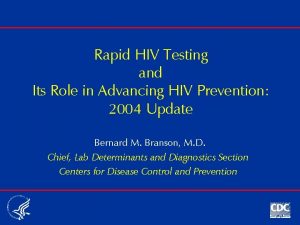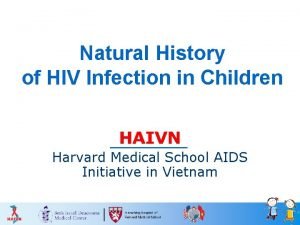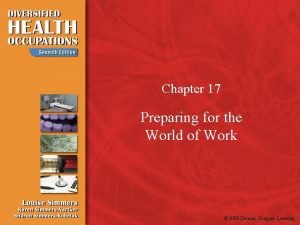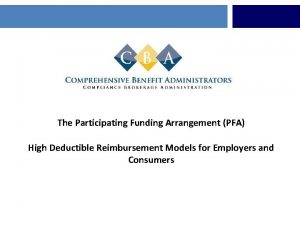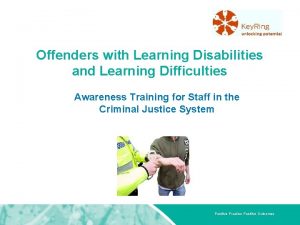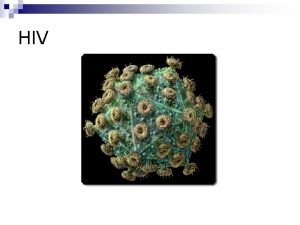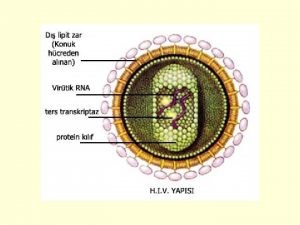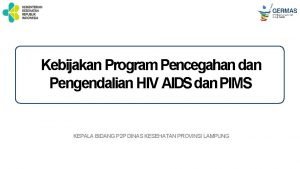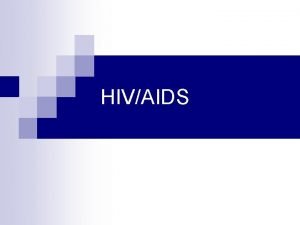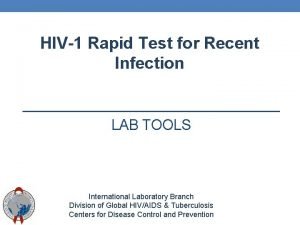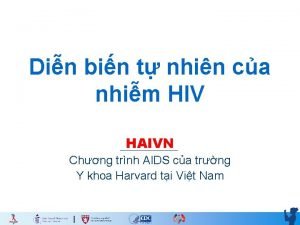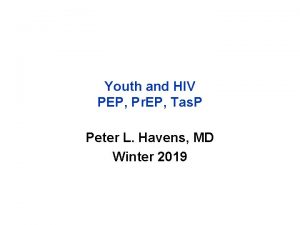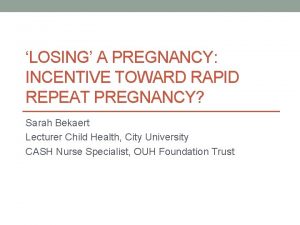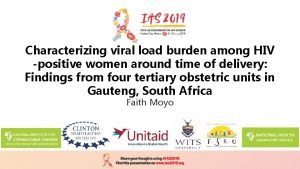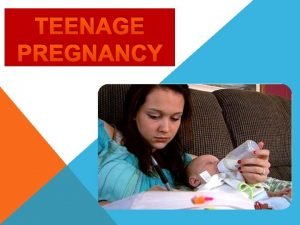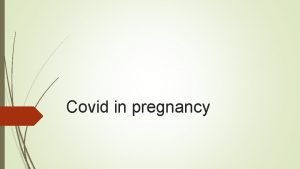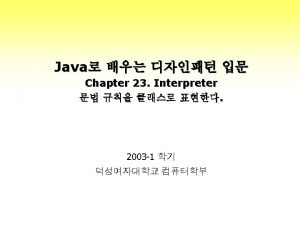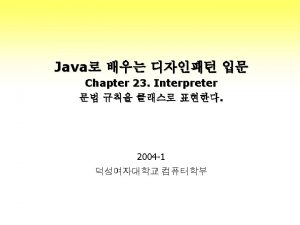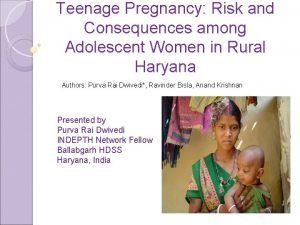Repeat Pregnancy among HIV Positive Women Participating in






















- Slides: 22

Repeat Pregnancy among HIV Positive Women Participating in a Prevention of Mother to Child Transmission Study- the Kisumu Breastfeeding Study, Kisumu, Kenya Mary Nyikuri, R. Masaba, R. Ndivo, T. Thomas Kenya Medical Research Institute/Centers for Disease Control and Prevention

Where is Kisumu? Siaya town Bondo town Lake Victoria Equator Kisumu CDC/KEMRI Clinical Research Center (CRC) at Provincial Hospital KENYA

Background • The prevalence of HIV infected women in Kenya high (9. 2%) • Prevalence among pregnant women 9. 6% • Pregnancies for HIV infected mothers a challenge because: – Desire to have children vs. risk of transmitting HIV to infants • Role for ARVs in PMTCT – Most women with HIV are infected in early adulthood • A critical time regarding decisions about reproduction, contraception – Many discover their HIV status • when already pregnant • in the absence of their male partners

Kisumu Breastfeeding Study (Ki. BS) • Design: Phase IIB, open label, one arm trial • Aim: To prevent mother to child transmission (PMTCT) among HIV- infected women – In resource limited setting – Through maximal reduction in viral load – By use of maternal HAART – From 34 weeks gestation through 6 months postpartum

Ki. BS Study participants were: – Encouraged to exclusively breastfeed for 5½months with rapid weaning at 6 months – Followed for two years postpartum – Informed that repeat pregnancies not eligible for study intervention

Ki. BS • Reproductive health counseling provided • For those who opted: – Initiated Depo-Provera • referred to government health facilities for continuation – Provided male and female condoms – Referred to hospital for tubal ligation, IUCD insertion and oral contraceptives

Objectives of this analysis To describe: • The extent of repeat pregnancies • Factors associated with a repeat pregnancy – Contraceptive use • Participant plans for reducing risk of infant HIV infection

Methods - Data • Baseline demographics • Possible associated factors: • • • Death of infant HIV infection of infant Sex of infant Living with baby’s father Number of living children

Methods (cont’d) • For repeat pregnancy – When Pregnancy occurred – Whether pregnancy was planned • use of contraceptives – Mother’s feelings about the pregnancy – Registration at antenatal clinic – Plans for PMTCT and infant feeding

Results • 522 participants enrolled – 21 withdrew – 1 died (before delivery) • 500 delivered in the study – 491 had live births – 9 had still births. • Repeat pregnancy occurred in 71/500 (14. 2%) – Data are only available for 46 as at 15 th July 2008

Results: Demographics No repeat pregnancy n = 463 Age - median (range) Parity – median (range) 24 (15 -43) Repeat pregnancy n = 46 22 (16 -30) 1 (0 -8) 1 (0 -4) Education Never attended school Primary Secondary Tertiary 12 (3%) 269 (59%) 154 (34%) 19 (4%) 1 (3%) 28 (76%) 8 (22%) 0 (0%) Marital Status Never married Married Divorced/Separated Widowed 338 (74%) 59 (13%) 22 (5%) 35 (8%) 36 (81%) 5 (13%) 3 (3%) 2 (3%) P-value 0. 0051 0. 08

Results: Infant factors No repeat pregnancy n = 454 Death of study infant a HIV infection of study infant Male infant b Repeat pregnancy n = 46 Relative Risk (95% CI) 3 (6%) 0. 60 (0. 19 -1. 87) 25 (6%) 5 (11%) 1. 19 (0. 82 -4. 48) 240 (53%) 31 (67%) 49 (11%) 1. 76 (0. 98 -3. 18)

Results: Other factors No repeat pregnancy n = 454 Mother living with father of baby Number of living children < 1 a Repeat pregnancy n = 46 Relative Risk (95% CI) 326 (72%) 36 (78%) 1. 36 (0. 70 -2. 67) 321 (71%) 37 (80%) 1. 62 (0. 80 -3. 27)

Results: Pregnancy details (n=46) • Knew when pregnancy occurred = 23 (51%) • Pregnancy was unplanned = 40 (87%)

Feelings about pregnancy Sad 23 (50%) Happy 7 (15%) Indifferent 10 (22%) Angry 6 (13%) Other 4 (9%) Reasons for any other feeling other than happy Did not want more children 19 (49%) Don’t have a husband, it would be difficult 11 (28%) Too sick to take care of children 4 ( 10%)

Contraceptive Use n=46 Used contraceptives Always 9 (20%) Sometimes 7 (15%) Never 30 (65%)

Reasons for not using contraceptives Thinking about it 12 (41%) Husband refused 10 (34%) Husband wanted more children 7 (24%) Wanted more children 5 (17%)

Plans for PMTCT and infant feeding • PMTCT – Take maternal NVP from ANC – Single dose infant NVP – Register at an ANC – On ARV treatment 29 17 8 5 (64%) (38%) (17%) (11%) 26 (57%) • Infant feeding – Planned to exclusively breast feed

Conclusion- (1) • 14. 2% of women in Ki. BS had a repeat pregnancy • Most (87%) of the pregnancies were unplanned • Despite counseling on family planning – 65% had never used any method during the study – 35% mentioned male partner’s refusal

Conclusion (2) • Death, sex and HIV infection of the study infant • Number of living children, and partner living – (not found to be factors for repeat pregnancy) • Half stated they would exclusively breastfeed • Most planned to take maternal NVP from ANC

Recommendation • Empower women with skills in reproductive health decision making • Focus not only on women, involve male partners in antenatal and postnatal clinics – Couple testing – Family planning 21

Acknowledgement • Ki. BS participants • Ki. BS staff • KEMRI/CDC • Disclaimer The findings and conclusions in this presentation have not been formally disseminated by the Centers for Disease Control and Prevention and should not be construed to represent any agency determination or policy”
 Implantation spotting
Implantation spotting Hiv rapid test results
Hiv rapid test results Risk of blood transfusion
Risk of blood transfusion Blood clotting positive feedback diagram
Blood clotting positive feedback diagram Thank you for participating images
Thank you for participating images View of participating classes
View of participating classes Telling selling participating delegating
Telling selling participating delegating Chapter 18:1 preparing for the world of work
Chapter 18:1 preparing for the world of work Kyra is participating in a fundraiser walk a thon
Kyra is participating in a fundraiser walk a thon Chapter 17:1 developing job keeping skills
Chapter 17:1 developing job keeping skills Participating contracts
Participating contracts Participating funding arrangement
Participating funding arrangement Agar
Agar Adding and subtracting negative numbers rules
Adding and subtracting negative numbers rules Positive practice positive outcomes
Positive practice positive outcomes Chronic hyperplastic candidiasis
Chronic hyperplastic candidiasis Hiv in adults
Hiv in adults Hiv pencere dönemi
Hiv pencere dönemi Prinsip notifikasi pasangan
Prinsip notifikasi pasangan What does hiv stand
What does hiv stand Asante hiv-1 rapid recency assay
Asante hiv-1 rapid recency assay Triệu chứng nhiễm hiv
Triệu chứng nhiễm hiv Unaids pdf
Unaids pdf

